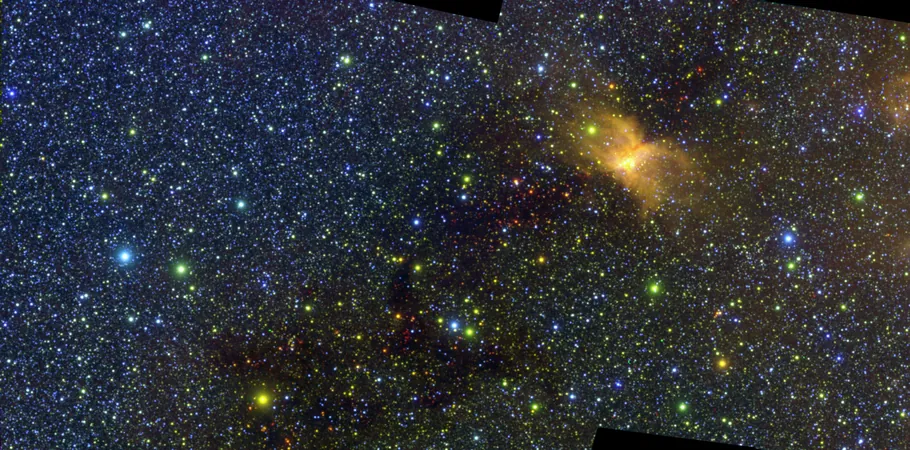
Unlocking the Universe: How NASA's SPHEREx Mission Is Sharing Cosmic Secrets with the World
2025-07-03
Author: Siti
NASA's SPHEREx Mission Takes Flight!
In an exhilarating leap into the cosmos, NASA's groundbreaking astrophysics space telescope, SPHEREx, launched earlier this year and has now settled into low-Earth orbit. This mission aims to create an unprecedented all-sky map of the universe, and it's doing so by sharing its findings with the world every week.
A New Era in Astrological Exploration
With its comprehensive gaze at the heavens, SPHEREx (Spectro-Photometer for the History of the Universe, Epoch of Reionization, and Ices Explorer) is set to revolutionize our understanding of the cosmos. According to Rachel Akeson, the lead for the SPHEREx Science Data Center at IPAC in Pasadena, California, this mission opens doors for nearly every field of astronomy, thanks to its extensive range of data.
Going Beyond Previous Missions
While its predecessor, the now-retired WISE (Wide-field Infrared Survey Explorer), mapped the sky using just four infrared wavelengths, SPHEREx elevates the game by observing in a stunning 102 wavelength bands. This rich spectrum allows scientists to employ spectroscopy to identify the elusive signatures of molecules, illuminating the distribution of vital components like frozen water and organic molecules—the very "building blocks of life".
Deciphering the Universe's Past
But there's more! SPHEREx will also delve into cosmic history, exploring the forces that caused the universe's rapid expansion after the Big Bang and tracking how the luminosity of galaxies has evolved over time. By opening its treasure trove of data to the public within just 60 days of collection, SPHEREx enhances the astronomical community's ability to conduct innovative research beyond what the mission team can achieve alone.
A Call to Astronomers Everywhere
Akeson emphasizes the mission's commitment to collaboration: "By making the data public, we enable the entire astronomy community to tap into SPHEREx's findings and explore new scientific avenues." This dedication to transparency is vital in fostering efficiency and driving discoveries.
Mapping the Stars Twice a Year
Over its two-year prime mission, SPHEREx is set to survey the sky twice each year, culminating in four all-sky maps. After the first year, a groundbreaking map presenting the entire sky across all 102 wavelengths will become available, ushering in new opportunities for discovery.
Synergy with Other Missions
SPHEREx is not just a standalone marvel; when combined with data from missions like NASA's James Webb Space Telescope and TESS (Transiting Exoplanet Survey Satellite), it could pinpoint intriguing targets for further exploration. It will even aid in the study of dark matter and dark energy alongside ESA's Euclid mission and NASA's upcoming Nancy Grace Roman Space Telescope.
A Universe of Possibilities
Vandana Desai, the IRSA Science Lead, enthusiastically notes that SPHEREx is part of a grand legacy of NASA space surveys, predicting, "People will utilize this data in unimaginable ways!" With such vast potential, the universe may soon unveil its mysteries like never before.




 Brasil (PT)
Brasil (PT)
 Canada (EN)
Canada (EN)
 Chile (ES)
Chile (ES)
 Česko (CS)
Česko (CS)
 대한민국 (KO)
대한민국 (KO)
 España (ES)
España (ES)
 France (FR)
France (FR)
 Hong Kong (EN)
Hong Kong (EN)
 Italia (IT)
Italia (IT)
 日本 (JA)
日本 (JA)
 Magyarország (HU)
Magyarország (HU)
 Norge (NO)
Norge (NO)
 Polska (PL)
Polska (PL)
 Schweiz (DE)
Schweiz (DE)
 Singapore (EN)
Singapore (EN)
 Sverige (SV)
Sverige (SV)
 Suomi (FI)
Suomi (FI)
 Türkiye (TR)
Türkiye (TR)
 الإمارات العربية المتحدة (AR)
الإمارات العربية المتحدة (AR)